Psychological Insights into Gun Shootings in the US
VerifiedAdded on 2023/06/10
|11
|2289
|285
AI Summary
This paper explores the psychological aspects of gun shootings in the US, including stereotyping, prejudice and discrimination, group influence, and aggression. It discusses the impact of stereotypes on individuals and groups, the connection between prejudice and discrimination, the influence of group dynamics on behavior, and the different types and causes of aggression. The paper also examines the role of environmental and physical factors in shaping aggressive behavior.
Contribute Materials
Your contribution can guide someone’s learning journey. Share your
documents today.

Running head: INTRODUCTIONTO PYSCHOLOGY- GUN SHOOTING IN THE US
Introduction to Psychology: Methods and Social
Student Name
University Affiliation
Introduction to Psychology: Methods and Social
Student Name
University Affiliation
Secure Best Marks with AI Grader
Need help grading? Try our AI Grader for instant feedback on your assignments.
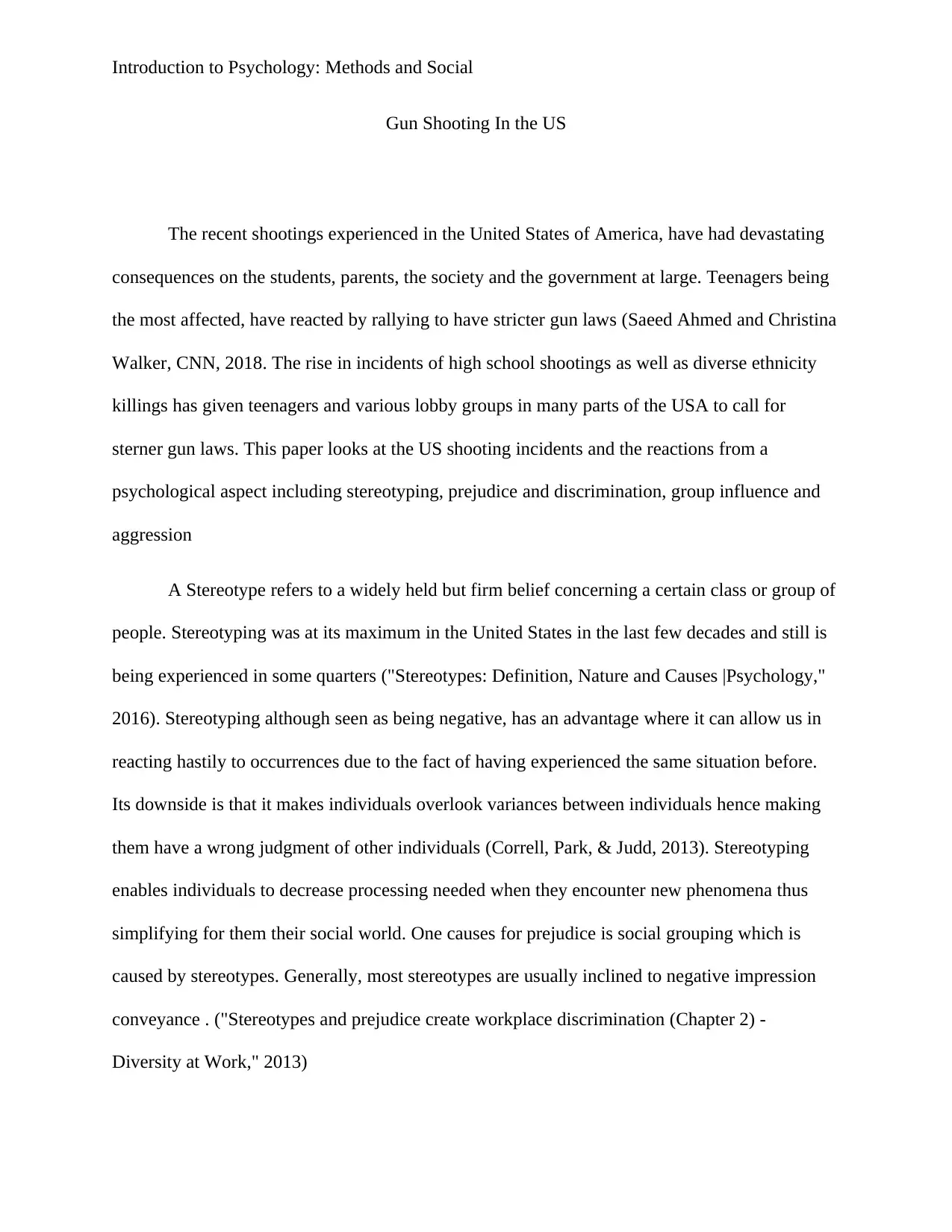
Introduction to Psychology: Methods and Social
Gun Shooting In the US
The recent shootings experienced in the United States of America, have had devastating
consequences on the students, parents, the society and the government at large. Teenagers being
the most affected, have reacted by rallying to have stricter gun laws (Saeed Ahmed and Christina
Walker, CNN, 2018. The rise in incidents of high school shootings as well as diverse ethnicity
killings has given teenagers and various lobby groups in many parts of the USA to call for
sterner gun laws. This paper looks at the US shooting incidents and the reactions from a
psychological aspect including stereotyping, prejudice and discrimination, group influence and
aggression
A Stereotype refers to a widely held but firm belief concerning a certain class or group of
people. Stereotyping was at its maximum in the United States in the last few decades and still is
being experienced in some quarters ("Stereotypes: Definition, Nature and Causes |Psychology,"
2016). Stereotyping although seen as being negative, has an advantage where it can allow us in
reacting hastily to occurrences due to the fact of having experienced the same situation before.
Its downside is that it makes individuals overlook variances between individuals hence making
them have a wrong judgment of other individuals (Correll, Park, & Judd, 2013). Stereotyping
enables individuals to decrease processing needed when they encounter new phenomena thus
simplifying for them their social world. One causes for prejudice is social grouping which is
caused by stereotypes. Generally, most stereotypes are usually inclined to negative impression
conveyance . ("Stereotypes and prejudice create workplace discrimination (Chapter 2) -
Diversity at Work," 2013)
Gun Shooting In the US
The recent shootings experienced in the United States of America, have had devastating
consequences on the students, parents, the society and the government at large. Teenagers being
the most affected, have reacted by rallying to have stricter gun laws (Saeed Ahmed and Christina
Walker, CNN, 2018. The rise in incidents of high school shootings as well as diverse ethnicity
killings has given teenagers and various lobby groups in many parts of the USA to call for
sterner gun laws. This paper looks at the US shooting incidents and the reactions from a
psychological aspect including stereotyping, prejudice and discrimination, group influence and
aggression
A Stereotype refers to a widely held but firm belief concerning a certain class or group of
people. Stereotyping was at its maximum in the United States in the last few decades and still is
being experienced in some quarters ("Stereotypes: Definition, Nature and Causes |Psychology,"
2016). Stereotyping although seen as being negative, has an advantage where it can allow us in
reacting hastily to occurrences due to the fact of having experienced the same situation before.
Its downside is that it makes individuals overlook variances between individuals hence making
them have a wrong judgment of other individuals (Correll, Park, & Judd, 2013). Stereotyping
enables individuals to decrease processing needed when they encounter new phenomena thus
simplifying for them their social world. One causes for prejudice is social grouping which is
caused by stereotypes. Generally, most stereotypes are usually inclined to negative impression
conveyance . ("Stereotypes and prejudice create workplace discrimination (Chapter 2) -
Diversity at Work," 2013)

Introduction to Psychology: Methods and Social
In the United States as well as in the broader world, there exist various types of
stereotypes including ethnic, racial and cultural types.
Stereotyping in the US has taken mostly the racial angle have had several ugly
consequences("Stereotypes | Simply Psychology," n.d.) .The African American being
stereotyped as being the lazy, smuggling and malicious type have faced more extrajudicial
killings from the law enforcers in the US. Although some scholars can argue that profiling gives
a group a sense of belonging and even make them work harder for the betterment of their
category, the shootings of the blacks in the US is not a thing to go with (Shapiro JR and Neuberg
SL, n.d.)
Prejudice and discrimination
There exists a direct connection between prejudice and discrimination in today’s world.
Prejudice refers to the unsubstantiated negative attitudes held by some individuals against others
belonging to a particular group. Homophobia, sexism religious persecution, and racism are some
instances of prejudice. Lacking reasonable bigotry, preconception is usually pre-formed.
Discrimination on the other side entails all those actions carried out by individuals
against those that they hold prejudices toward. In the United States, discrimination was prevalent
during those days of black and white segregation or variances in payment for a male and female
working in the same division. A more subtle or passive-aggressive, behavior displayed by the
white law enforcers against black civilians in America through their shooting of unarmed
teenagers is another discriminatory behavior ("Chapter 12: Stereotypes, Prejudice, and
Discrimination | Principles of Social Psychology," 2015).
In the United States as well as in the broader world, there exist various types of
stereotypes including ethnic, racial and cultural types.
Stereotyping in the US has taken mostly the racial angle have had several ugly
consequences("Stereotypes | Simply Psychology," n.d.) .The African American being
stereotyped as being the lazy, smuggling and malicious type have faced more extrajudicial
killings from the law enforcers in the US. Although some scholars can argue that profiling gives
a group a sense of belonging and even make them work harder for the betterment of their
category, the shootings of the blacks in the US is not a thing to go with (Shapiro JR and Neuberg
SL, n.d.)
Prejudice and discrimination
There exists a direct connection between prejudice and discrimination in today’s world.
Prejudice refers to the unsubstantiated negative attitudes held by some individuals against others
belonging to a particular group. Homophobia, sexism religious persecution, and racism are some
instances of prejudice. Lacking reasonable bigotry, preconception is usually pre-formed.
Discrimination on the other side entails all those actions carried out by individuals
against those that they hold prejudices toward. In the United States, discrimination was prevalent
during those days of black and white segregation or variances in payment for a male and female
working in the same division. A more subtle or passive-aggressive, behavior displayed by the
white law enforcers against black civilians in America through their shooting of unarmed
teenagers is another discriminatory behavior ("Chapter 12: Stereotypes, Prejudice, and
Discrimination | Principles of Social Psychology," 2015).
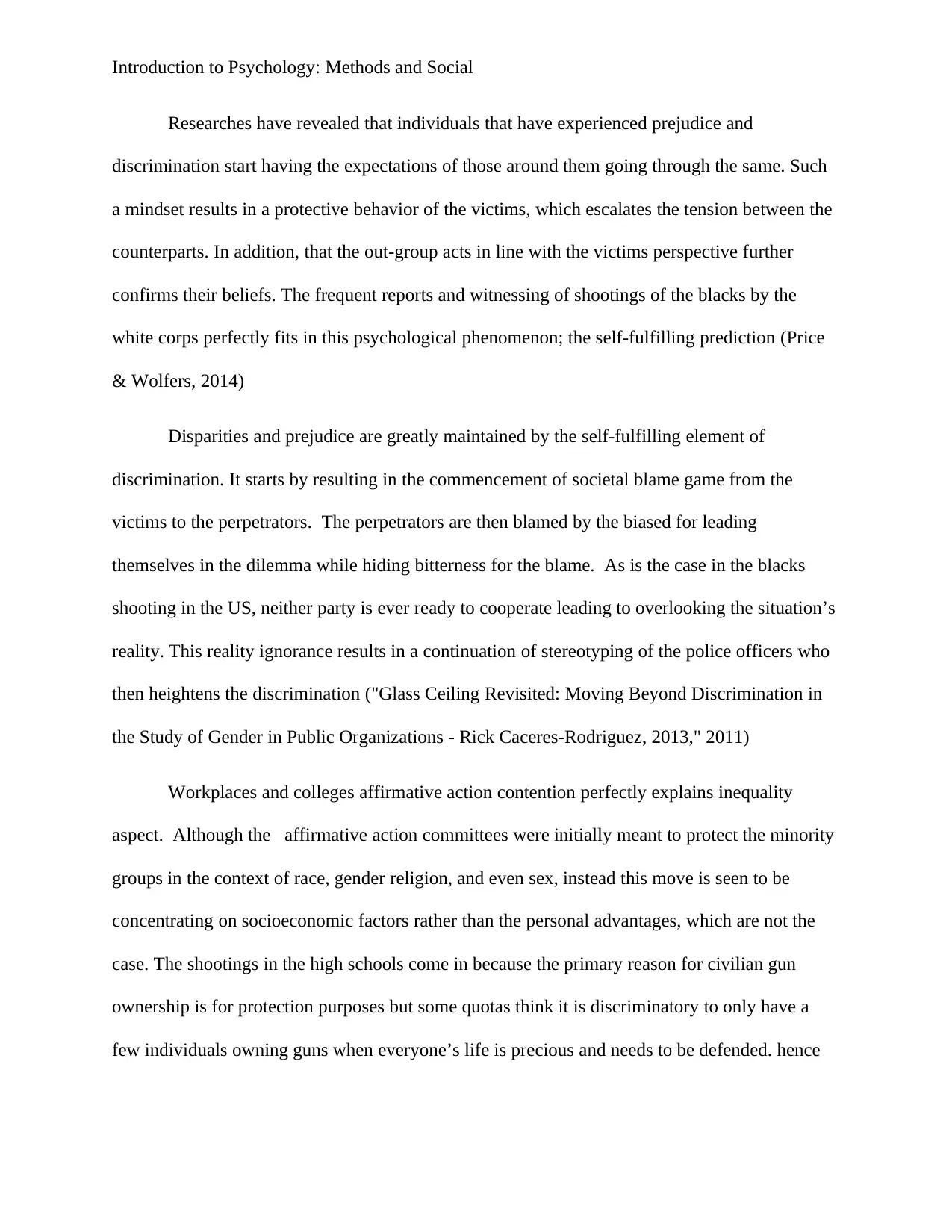
Introduction to Psychology: Methods and Social
Researches have revealed that individuals that have experienced prejudice and
discrimination start having the expectations of those around them going through the same. Such
a mindset results in a protective behavior of the victims, which escalates the tension between the
counterparts. In addition, that the out-group acts in line with the victims perspective further
confirms their beliefs. The frequent reports and witnessing of shootings of the blacks by the
white corps perfectly fits in this psychological phenomenon; the self-fulfilling prediction (Price
& Wolfers, 2014)
Disparities and prejudice are greatly maintained by the self-fulfilling element of
discrimination. It starts by resulting in the commencement of societal blame game from the
victims to the perpetrators. The perpetrators are then blamed by the biased for leading
themselves in the dilemma while hiding bitterness for the blame. As is the case in the blacks
shooting in the US, neither party is ever ready to cooperate leading to overlooking the situation’s
reality. This reality ignorance results in a continuation of stereotyping of the police officers who
then heightens the discrimination ("Glass Ceiling Revisited: Moving Beyond Discrimination in
the Study of Gender in Public Organizations - Rick Caceres-Rodriguez, 2013," 2011)
Workplaces and colleges affirmative action contention perfectly explains inequality
aspect. Although the affirmative action committees were initially meant to protect the minority
groups in the context of race, gender religion, and even sex, instead this move is seen to be
concentrating on socioeconomic factors rather than the personal advantages, which are not the
case. The shootings in the high schools come in because the primary reason for civilian gun
ownership is for protection purposes but some quotas think it is discriminatory to only have a
few individuals owning guns when everyone’s life is precious and needs to be defended. hence
Researches have revealed that individuals that have experienced prejudice and
discrimination start having the expectations of those around them going through the same. Such
a mindset results in a protective behavior of the victims, which escalates the tension between the
counterparts. In addition, that the out-group acts in line with the victims perspective further
confirms their beliefs. The frequent reports and witnessing of shootings of the blacks by the
white corps perfectly fits in this psychological phenomenon; the self-fulfilling prediction (Price
& Wolfers, 2014)
Disparities and prejudice are greatly maintained by the self-fulfilling element of
discrimination. It starts by resulting in the commencement of societal blame game from the
victims to the perpetrators. The perpetrators are then blamed by the biased for leading
themselves in the dilemma while hiding bitterness for the blame. As is the case in the blacks
shooting in the US, neither party is ever ready to cooperate leading to overlooking the situation’s
reality. This reality ignorance results in a continuation of stereotyping of the police officers who
then heightens the discrimination ("Glass Ceiling Revisited: Moving Beyond Discrimination in
the Study of Gender in Public Organizations - Rick Caceres-Rodriguez, 2013," 2011)
Workplaces and colleges affirmative action contention perfectly explains inequality
aspect. Although the affirmative action committees were initially meant to protect the minority
groups in the context of race, gender religion, and even sex, instead this move is seen to be
concentrating on socioeconomic factors rather than the personal advantages, which are not the
case. The shootings in the high schools come in because the primary reason for civilian gun
ownership is for protection purposes but some quotas think it is discriminatory to only have a
few individuals owning guns when everyone’s life is precious and needs to be defended. hence
Secure Best Marks with AI Grader
Need help grading? Try our AI Grader for instant feedback on your assignments.

Introduction to Psychology: Methods and Social
as revealed by scholars, discrimination and bias all add fuel to the burning inequality in the
United States.
Group Influence
Group influence refers to two or more individuals who cooperate with, sway each other
and see one another as a unit.
Groups hold characteristics such as the suitable behavior, the roles allocated to individuals that
shape their behaviors as well as the duties the individuals can execute and the communication
along with power structure that controls the conversation and authority in the group .
In addition, the group size in which the bigger it is the more agreement it will have until
some limit where the group conformity ceases to hold. The school shootings have one of the
massive groups together in the history of US education
Researchers have revealed that conformity also increases when an individual has a
feeling of insecurity together with incompetency, has an admiration for the group or the fact that
the group itself can monitor the individual’s behavior
Reasons for Conforming
A number of reasons for conforming exist like individuals seeking acceptance or dread
exclusion by a certain group, it’s a source of information, targeting a social reward, have
admiration for the group and could wish to be the members of that group. Productivity in Groups
has a tendency of decreasing due to lack of enough coordination and the social loafing aspect
whereas in big groups, the same task may be repeated while other decisions of the tasks get
neglected.
as revealed by scholars, discrimination and bias all add fuel to the burning inequality in the
United States.
Group Influence
Group influence refers to two or more individuals who cooperate with, sway each other
and see one another as a unit.
Groups hold characteristics such as the suitable behavior, the roles allocated to individuals that
shape their behaviors as well as the duties the individuals can execute and the communication
along with power structure that controls the conversation and authority in the group .
In addition, the group size in which the bigger it is the more agreement it will have until
some limit where the group conformity ceases to hold. The school shootings have one of the
massive groups together in the history of US education
Researchers have revealed that conformity also increases when an individual has a
feeling of insecurity together with incompetency, has an admiration for the group or the fact that
the group itself can monitor the individual’s behavior
Reasons for Conforming
A number of reasons for conforming exist like individuals seeking acceptance or dread
exclusion by a certain group, it’s a source of information, targeting a social reward, have
admiration for the group and could wish to be the members of that group. Productivity in Groups
has a tendency of decreasing due to lack of enough coordination and the social loafing aspect
whereas in big groups, the same task may be repeated while other decisions of the tasks get
neglected.

Introduction to Psychology: Methods and Social
Group polarization, which is essentially the incidence where after a group discussion, the
paramount opinion is strengthened to ultimate position. In situations where, a comparatively
risky view that is radical, a more risky agreement is set to be arrived at in situation referred to as
the risky shift.
Concerning the minority influence in which, a bigger opinion can be overturned by a
smaller but dedicated group that has an unshaken opinion. Deindividuation which happens in
large groups within which individuals lose the sense accountability and no longer have self-
judgment after losing restrictions.
Aggression
Aggression entails those manners that are able to cause both psychological and physical
harm to, others, objects in the surroundings and oneself. Generally, aggression targets hurting or
other individuals either mentally or physically. Aggression can be signifying an underlying
medical mental, substance or any health disorder. The world’s highest ranked shootings in the
various high schools in America are mostly thought to be motivated by one of the above
underlying causes ("Fact Check: Does the U.S. Experience Far More School Shootings than Any
Other Country?" n.d.)
Forms of Aggression
Physical, verbal, mental and emotional aggression forms in existence. Ranging from
intimidation, underrating others verbally to hitting and pushing are all form s of aggression
Aggression carried out by individuals serve various purposes including anger or hostility
expression, authority assertion, achievement of certain goals, as a form of possession expression,
as a response to fear, reaction to pain and as a competition with rivals ("Biological and
Group polarization, which is essentially the incidence where after a group discussion, the
paramount opinion is strengthened to ultimate position. In situations where, a comparatively
risky view that is radical, a more risky agreement is set to be arrived at in situation referred to as
the risky shift.
Concerning the minority influence in which, a bigger opinion can be overturned by a
smaller but dedicated group that has an unshaken opinion. Deindividuation which happens in
large groups within which individuals lose the sense accountability and no longer have self-
judgment after losing restrictions.
Aggression
Aggression entails those manners that are able to cause both psychological and physical
harm to, others, objects in the surroundings and oneself. Generally, aggression targets hurting or
other individuals either mentally or physically. Aggression can be signifying an underlying
medical mental, substance or any health disorder. The world’s highest ranked shootings in the
various high schools in America are mostly thought to be motivated by one of the above
underlying causes ("Fact Check: Does the U.S. Experience Far More School Shootings than Any
Other Country?" n.d.)
Forms of Aggression
Physical, verbal, mental and emotional aggression forms in existence. Ranging from
intimidation, underrating others verbally to hitting and pushing are all form s of aggression
Aggression carried out by individuals serve various purposes including anger or hostility
expression, authority assertion, achievement of certain goals, as a form of possession expression,
as a response to fear, reaction to pain and as a competition with rivals ("Biological and
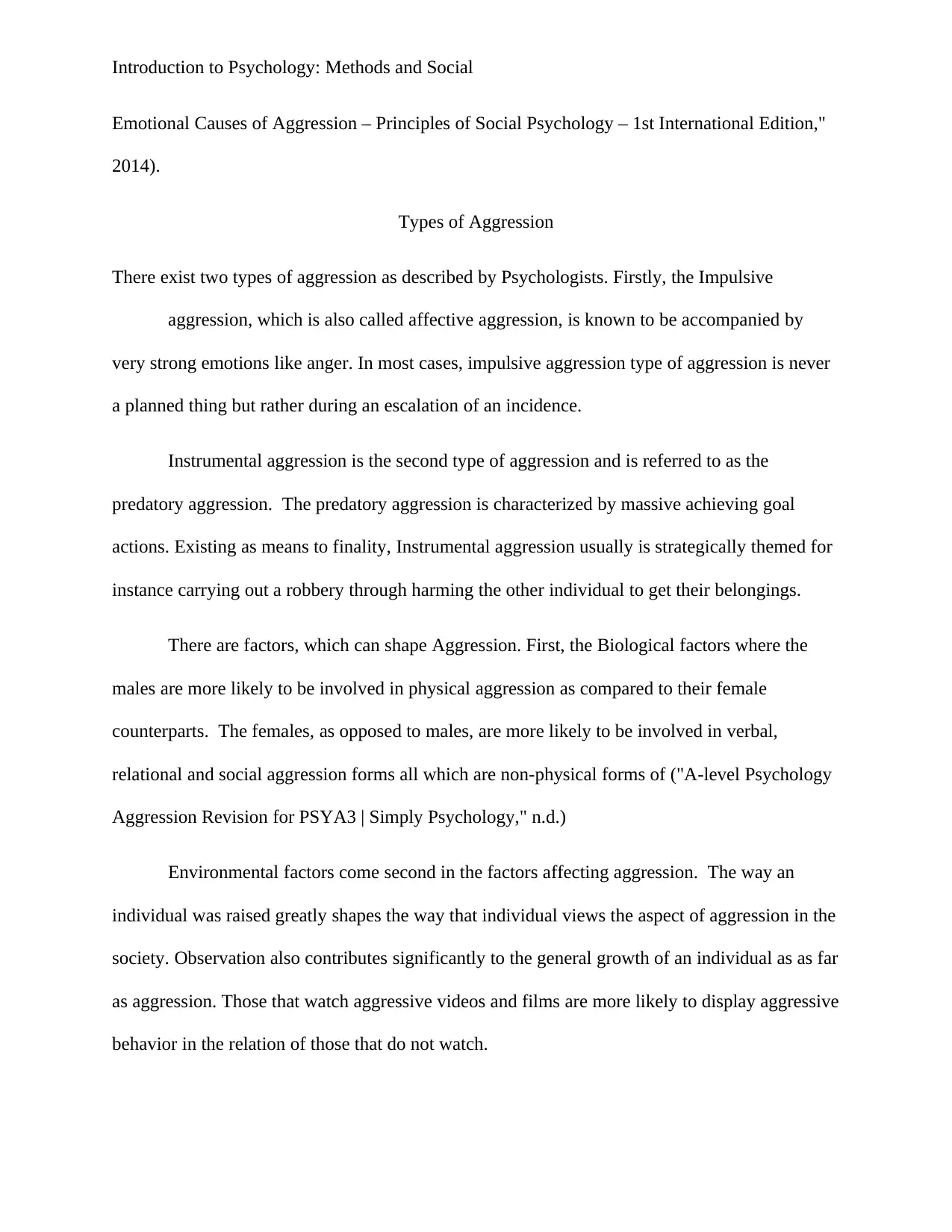
Introduction to Psychology: Methods and Social
Emotional Causes of Aggression – Principles of Social Psychology – 1st International Edition,"
2014).
Types of Aggression
There exist two types of aggression as described by Psychologists. Firstly, the Impulsive
aggression, which is also called affective aggression, is known to be accompanied by
very strong emotions like anger. In most cases, impulsive aggression type of aggression is never
a planned thing but rather during an escalation of an incidence.
Instrumental aggression is the second type of aggression and is referred to as the
predatory aggression. The predatory aggression is characterized by massive achieving goal
actions. Existing as means to finality, Instrumental aggression usually is strategically themed for
instance carrying out a robbery through harming the other individual to get their belongings.
There are factors, which can shape Aggression. First, the Biological factors where the
males are more likely to be involved in physical aggression as compared to their female
counterparts. The females, as opposed to males, are more likely to be involved in verbal,
relational and social aggression forms all which are non-physical forms of ("A-level Psychology
Aggression Revision for PSYA3 | Simply Psychology," n.d.)
Environmental factors come second in the factors affecting aggression. The way an
individual was raised greatly shapes the way that individual views the aspect of aggression in the
society. Observation also contributes significantly to the general growth of an individual as as far
as aggression. Those that watch aggressive videos and films are more likely to display aggressive
behavior in the relation of those that do not watch.
Emotional Causes of Aggression – Principles of Social Psychology – 1st International Edition,"
2014).
Types of Aggression
There exist two types of aggression as described by Psychologists. Firstly, the Impulsive
aggression, which is also called affective aggression, is known to be accompanied by
very strong emotions like anger. In most cases, impulsive aggression type of aggression is never
a planned thing but rather during an escalation of an incidence.
Instrumental aggression is the second type of aggression and is referred to as the
predatory aggression. The predatory aggression is characterized by massive achieving goal
actions. Existing as means to finality, Instrumental aggression usually is strategically themed for
instance carrying out a robbery through harming the other individual to get their belongings.
There are factors, which can shape Aggression. First, the Biological factors where the
males are more likely to be involved in physical aggression as compared to their female
counterparts. The females, as opposed to males, are more likely to be involved in verbal,
relational and social aggression forms all which are non-physical forms of ("A-level Psychology
Aggression Revision for PSYA3 | Simply Psychology," n.d.)
Environmental factors come second in the factors affecting aggression. The way an
individual was raised greatly shapes the way that individual views the aspect of aggression in the
society. Observation also contributes significantly to the general growth of an individual as as far
as aggression. Those that watch aggressive videos and films are more likely to display aggressive
behavior in the relation of those that do not watch.
Paraphrase This Document
Need a fresh take? Get an instant paraphrase of this document with our AI Paraphraser
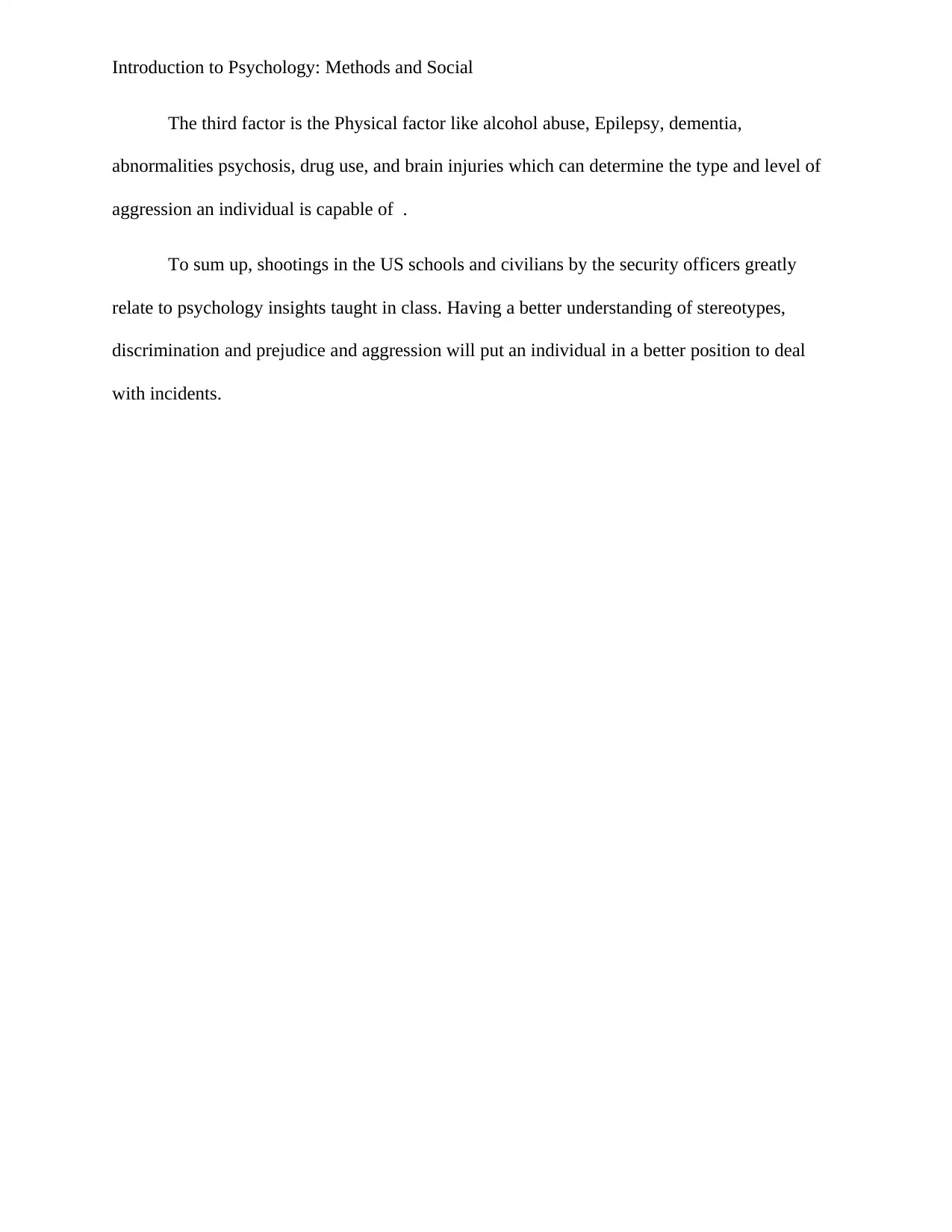
Introduction to Psychology: Methods and Social
The third factor is the Physical factor like alcohol abuse, Epilepsy, dementia,
abnormalities psychosis, drug use, and brain injuries which can determine the type and level of
aggression an individual is capable of .
To sum up, shootings in the US schools and civilians by the security officers greatly
relate to psychology insights taught in class. Having a better understanding of stereotypes,
discrimination and prejudice and aggression will put an individual in a better position to deal
with incidents.
The third factor is the Physical factor like alcohol abuse, Epilepsy, dementia,
abnormalities psychosis, drug use, and brain injuries which can determine the type and level of
aggression an individual is capable of .
To sum up, shootings in the US schools and civilians by the security officers greatly
relate to psychology insights taught in class. Having a better understanding of stereotypes,
discrimination and prejudice and aggression will put an individual in a better position to deal
with incidents.
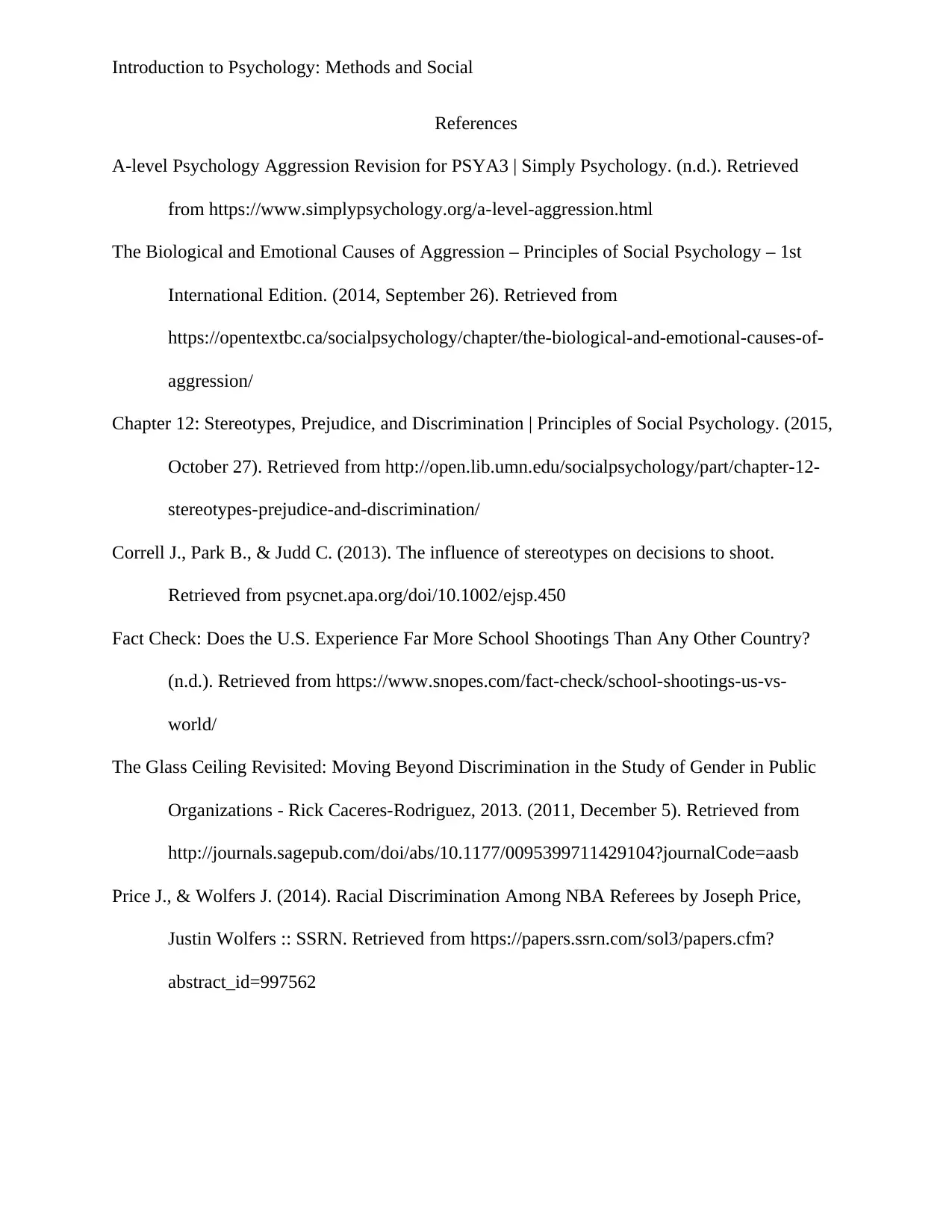
Introduction to Psychology: Methods and Social
References
A-level Psychology Aggression Revision for PSYA3 | Simply Psychology. (n.d.). Retrieved
from https://www.simplypsychology.org/a-level-aggression.html
The Biological and Emotional Causes of Aggression – Principles of Social Psychology – 1st
International Edition. (2014, September 26). Retrieved from
https://opentextbc.ca/socialpsychology/chapter/the-biological-and-emotional-causes-of-
aggression/
Chapter 12: Stereotypes, Prejudice, and Discrimination | Principles of Social Psychology. (2015,
October 27). Retrieved from http://open.lib.umn.edu/socialpsychology/part/chapter-12-
stereotypes-prejudice-and-discrimination/
Correll J., Park B., & Judd C. (2013). The influence of stereotypes on decisions to shoot.
Retrieved from psycnet.apa.org/doi/10.1002/ejsp.450
Fact Check: Does the U.S. Experience Far More School Shootings Than Any Other Country?
(n.d.). Retrieved from https://www.snopes.com/fact-check/school-shootings-us-vs-
world/
The Glass Ceiling Revisited: Moving Beyond Discrimination in the Study of Gender in Public
Organizations - Rick Caceres-Rodriguez, 2013. (2011, December 5). Retrieved from
http://journals.sagepub.com/doi/abs/10.1177/0095399711429104?journalCode=aasb
Price J., & Wolfers J. (2014). Racial Discrimination Among NBA Referees by Joseph Price,
Justin Wolfers :: SSRN. Retrieved from https://papers.ssrn.com/sol3/papers.cfm?
abstract_id=997562
References
A-level Psychology Aggression Revision for PSYA3 | Simply Psychology. (n.d.). Retrieved
from https://www.simplypsychology.org/a-level-aggression.html
The Biological and Emotional Causes of Aggression – Principles of Social Psychology – 1st
International Edition. (2014, September 26). Retrieved from
https://opentextbc.ca/socialpsychology/chapter/the-biological-and-emotional-causes-of-
aggression/
Chapter 12: Stereotypes, Prejudice, and Discrimination | Principles of Social Psychology. (2015,
October 27). Retrieved from http://open.lib.umn.edu/socialpsychology/part/chapter-12-
stereotypes-prejudice-and-discrimination/
Correll J., Park B., & Judd C. (2013). The influence of stereotypes on decisions to shoot.
Retrieved from psycnet.apa.org/doi/10.1002/ejsp.450
Fact Check: Does the U.S. Experience Far More School Shootings Than Any Other Country?
(n.d.). Retrieved from https://www.snopes.com/fact-check/school-shootings-us-vs-
world/
The Glass Ceiling Revisited: Moving Beyond Discrimination in the Study of Gender in Public
Organizations - Rick Caceres-Rodriguez, 2013. (2011, December 5). Retrieved from
http://journals.sagepub.com/doi/abs/10.1177/0095399711429104?journalCode=aasb
Price J., & Wolfers J. (2014). Racial Discrimination Among NBA Referees by Joseph Price,
Justin Wolfers :: SSRN. Retrieved from https://papers.ssrn.com/sol3/papers.cfm?
abstract_id=997562
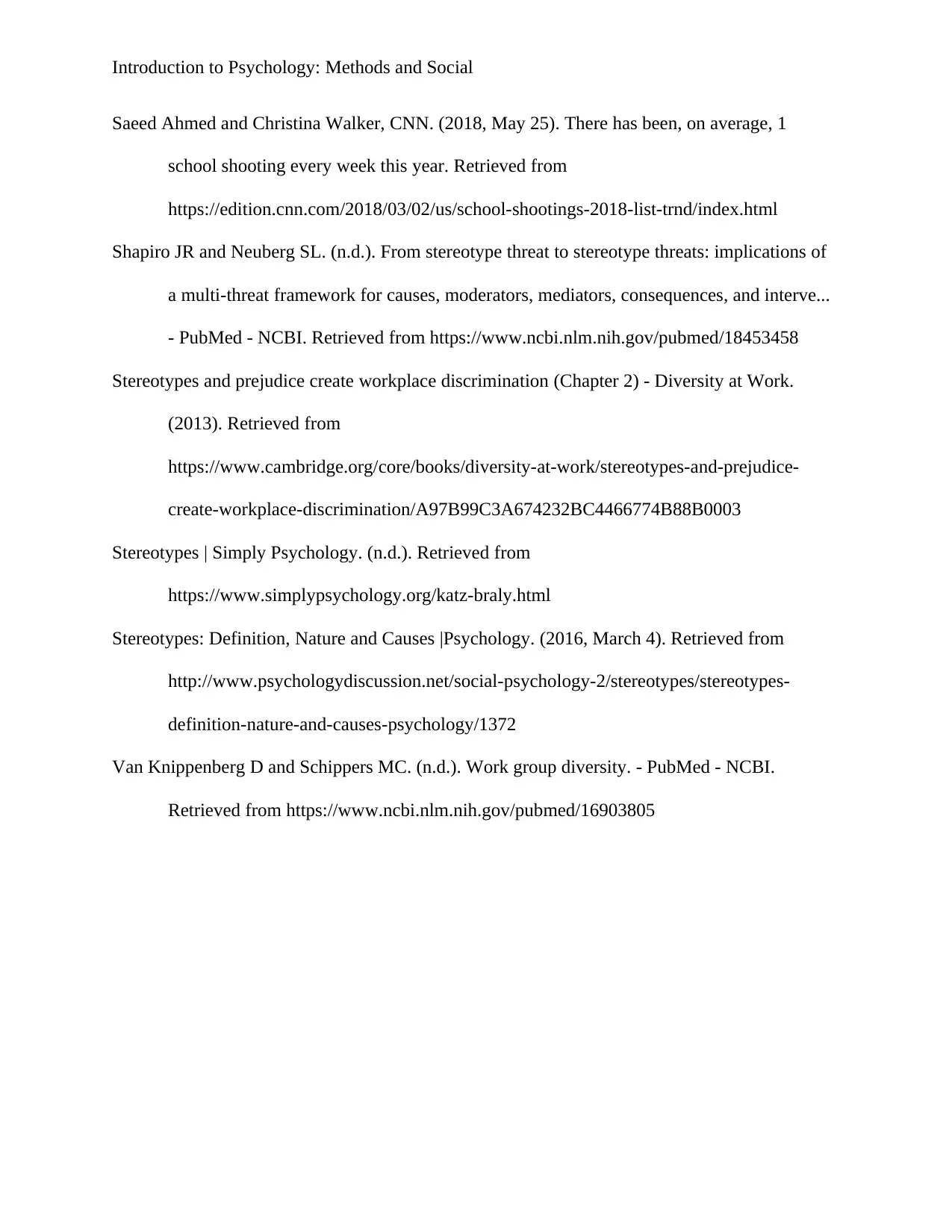
Introduction to Psychology: Methods and Social
Saeed Ahmed and Christina Walker, CNN. (2018, May 25). There has been, on average, 1
school shooting every week this year. Retrieved from
https://edition.cnn.com/2018/03/02/us/school-shootings-2018-list-trnd/index.html
Shapiro JR and Neuberg SL. (n.d.). From stereotype threat to stereotype threats: implications of
a multi-threat framework for causes, moderators, mediators, consequences, and interve...
- PubMed - NCBI. Retrieved from https://www.ncbi.nlm.nih.gov/pubmed/18453458
Stereotypes and prejudice create workplace discrimination (Chapter 2) - Diversity at Work.
(2013). Retrieved from
https://www.cambridge.org/core/books/diversity-at-work/stereotypes-and-prejudice-
create-workplace-discrimination/A97B99C3A674232BC4466774B88B0003
Stereotypes | Simply Psychology. (n.d.). Retrieved from
https://www.simplypsychology.org/katz-braly.html
Stereotypes: Definition, Nature and Causes |Psychology. (2016, March 4). Retrieved from
http://www.psychologydiscussion.net/social-psychology-2/stereotypes/stereotypes-
definition-nature-and-causes-psychology/1372
Van Knippenberg D and Schippers MC. (n.d.). Work group diversity. - PubMed - NCBI.
Retrieved from https://www.ncbi.nlm.nih.gov/pubmed/16903805
Saeed Ahmed and Christina Walker, CNN. (2018, May 25). There has been, on average, 1
school shooting every week this year. Retrieved from
https://edition.cnn.com/2018/03/02/us/school-shootings-2018-list-trnd/index.html
Shapiro JR and Neuberg SL. (n.d.). From stereotype threat to stereotype threats: implications of
a multi-threat framework for causes, moderators, mediators, consequences, and interve...
- PubMed - NCBI. Retrieved from https://www.ncbi.nlm.nih.gov/pubmed/18453458
Stereotypes and prejudice create workplace discrimination (Chapter 2) - Diversity at Work.
(2013). Retrieved from
https://www.cambridge.org/core/books/diversity-at-work/stereotypes-and-prejudice-
create-workplace-discrimination/A97B99C3A674232BC4466774B88B0003
Stereotypes | Simply Psychology. (n.d.). Retrieved from
https://www.simplypsychology.org/katz-braly.html
Stereotypes: Definition, Nature and Causes |Psychology. (2016, March 4). Retrieved from
http://www.psychologydiscussion.net/social-psychology-2/stereotypes/stereotypes-
definition-nature-and-causes-psychology/1372
Van Knippenberg D and Schippers MC. (n.d.). Work group diversity. - PubMed - NCBI.
Retrieved from https://www.ncbi.nlm.nih.gov/pubmed/16903805
Secure Best Marks with AI Grader
Need help grading? Try our AI Grader for instant feedback on your assignments.
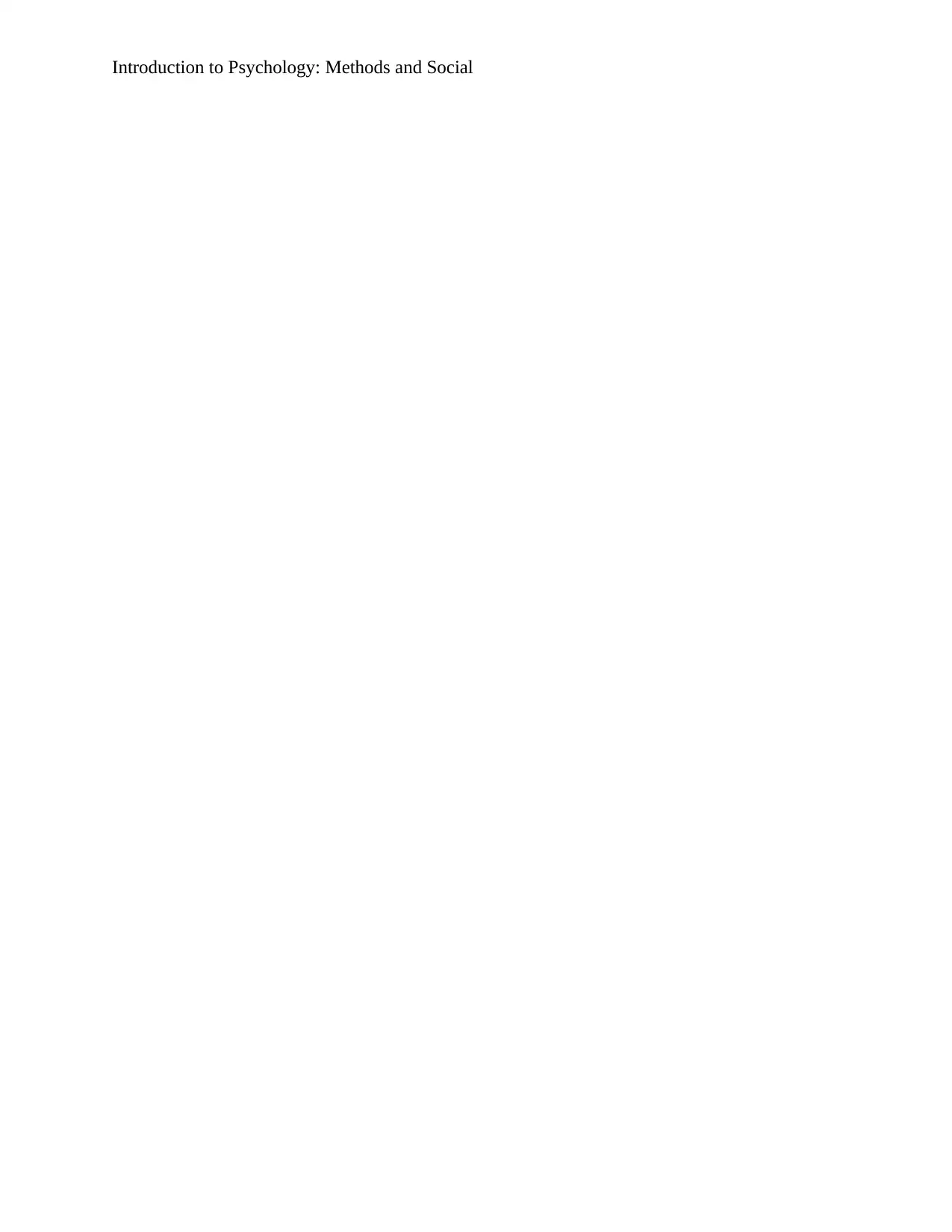
Introduction to Psychology: Methods and Social
1 out of 11
Related Documents
Your All-in-One AI-Powered Toolkit for Academic Success.
+13062052269
info@desklib.com
Available 24*7 on WhatsApp / Email
![[object Object]](/_next/static/media/star-bottom.7253800d.svg)
Unlock your academic potential
© 2024 | Zucol Services PVT LTD | All rights reserved.





